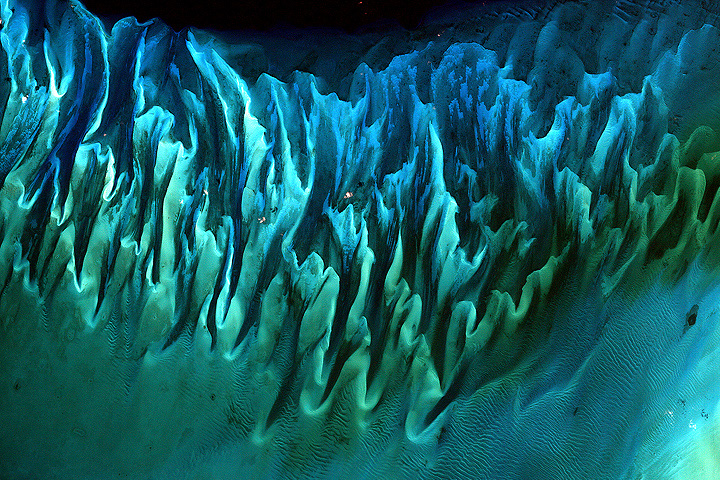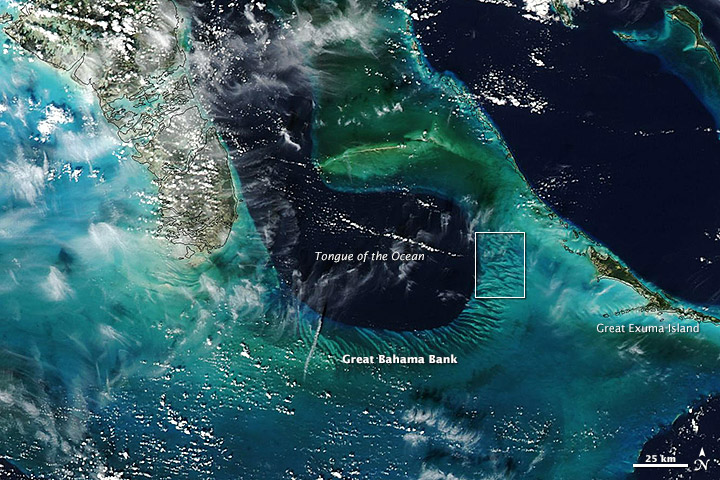Thirteen years ago, a satellite acquired this beautiful image (above) of light and sand playing off a portion of the ocean floor in the Bahamas. The caption that accompanied the image didn’t include many details, only noting that the image was acquired by the Enhanced Thematic Mapper Plus (ETM+) sensor on Landsat 7 and that, “tides and ocean currents in the Bahamas sculpted the sand and seaweed beds into these multicolored, fluted patterns in much the same way that winds sculpted the vast sand dunes in the Sahara Desert.”
An image as beautiful as this seemed like it deserved a bit more explanation, so I grabbed a recent (January 9, 2014) scene of the same area captured by the Moderate Resolution Imaging Spectroradiometer (MODIS) on the Aqua satellite. That image (below) shows a much broader view of the area. You can still see some details of the intricate network of dunes, but the MODIS image offers a much better sense of the regional geology. For instance, the section of dunes shown in the first image (the white box in the lower image) appear to be shoals made up small spherical grains of calcium carbonate known as ooids that sit on a larger limestone platform called the Great Bahama Bank. Limestone is a sedimentary rock formed by the skeletal fragments of sea creatures, including corals and foraminifera, and this particular limestone platform has been accumulating since at least the Cretaceous Period.
You can also see a sharp division between the shallow (turquoise) waters of the Great Bahama Bank and the much deeper (dark blue) parts of the ocean. The submarine canyon that separates Andros Island from Great Exuma Island is nearly cut off entirely from the ocean by the Great Bahama Bank, but not quite. A connection to deep waters to the north gives the trench the shape of a tongue, earning the feature the name “Tongue of the Ocean.” At its lowest point, the floor of the Tongue of the Ocean is about 14,060 feet (4,285 meters) lower than Great Bahama Bank. The shallowest (lightest) parts of the the feature, in contrast, are just a few feet deep.






its a great achivement to nasa.
Amazing photography! I would hope that seeing such beautiful images might inspire people to respect the earth more..
The staggering beauty of this dot we call ‘Earth’ never ceases to amaze me!! Gaia – Mother Earth <3
is that for real? couldnt believe there is great things such as this on the world.
If not for amazing shots and explanations like this,we would never see and know the the wonders of this earth
You couldn’t make this up… real life is so often much more dramatic than anything we can imagine!
These are ooid shoals (they are not limestone yet, as limestone is a rock and these are mobile grains). Ooids consist of chemically precipitated carbonate coatings around a nucleus (which can be other shells or sand grains) Ooids look like tiny, perfectly white pearls and in this location are 2-3 mm in diameter. They grow bigger here because of the incredibly strong tidal currents that rip across the platform, which keeps the ooids moving and aggitated. When the ooids bounce around they are lifted slightly in the water column which is where they can recieve a coating of calcium carbonate. I’m trying to keep this short and have simplified the complex sedimentology and hydrodynamics going on here, but it is truly an awesome place! There are other islands and ooid shoals in the Bahamas, which are more accessible and also have ooid sand and they are make the most fabulous beaches!
Kelly, thanks for your comment about ooids. Could you please post some links with more information about the differences between ooids and limestone in this region? I’d like to look into this some more.
EARTH and its AWESOMENESS. Whoa !!
These photos are AWESOME. I am truly happy to be a citizen of one of God’s greatest creations, The Commonwealth of The Bahamas. I am sharing with the students in the hope that they would appreciate and sustain the natural beauty of our great archipelago.